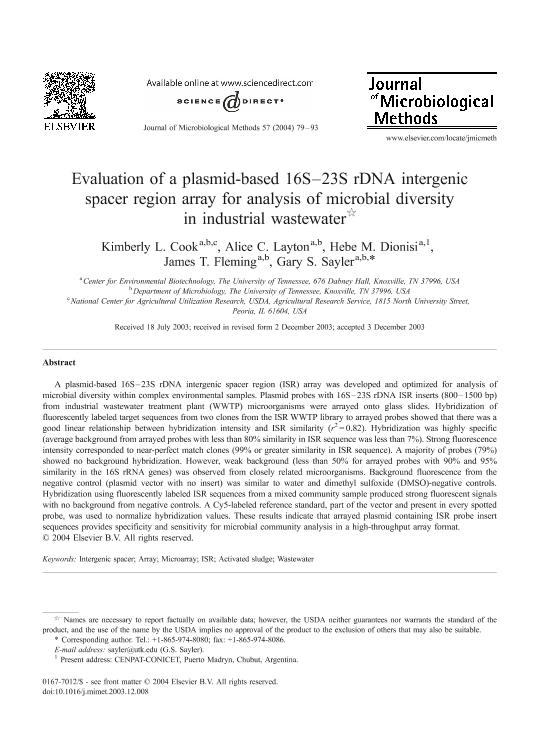Mostrar el registro sencillo del ítem
dc.contributor.author
Cook, Kimberly L.
dc.contributor.author
Layton, Alice C.
dc.contributor.author
Dionisi, Hebe Monica

dc.contributor.author
Fleming, James T.
dc.contributor.author
Sayler, Gary S.
dc.date.available
2020-05-04T18:21:59Z
dc.date.issued
2004-04
dc.identifier.citation
Cook, Kimberly L.; Layton, Alice C.; Dionisi, Hebe Monica; Fleming, James T.; Sayler, Gary S.; Evaluation of a plasmid-based 16S–23S rDNA intergenic spacer region array for analysis of microbial diversity in industrial wastewater; Elsevier Science; Journal of Microbiological Methods; 57; 1; 4-2004; 79-93
dc.identifier.issn
0167-7012
dc.identifier.uri
http://hdl.handle.net/11336/104169
dc.description.abstract
A plasmid-based 16S–23S rDNA intergenic spacer region (ISR) array was developed and optimized for analysis of microbial diversity within complex environmental samples. Plasmid probes with 16S–23S rDNA ISR inserts (800-1500 bp) from industrial wastewater treatment plant (WWTP) microorganisms were arrayed onto glass slides. Hybridization of fluorescently labeled target sequences from two clones from the ISR WWTP library to arrayed probes showed that there was a good linear relationship between hybridization intensity and ISR similarity (r2 = 0.82). Hybridization was highly specific (average background from arrayed probes with less than 80% similarity in ISR sequence was less than 7%). Strong fluorescence intensity corresponded to near-perfect match clones (99% or greater similarity in ISR sequence). A majority of probes (79%) showed no background hybridization. However, weak background (less than 50% for arrayed probes with 90% and 95% similarity in the 16S rRNA genes) was observed from closely related microorganisms. Background fluorescence from the negative control (plasmid vector with no insert) was similar to water and dimethyl sulfoxide (DMSO)-negative controls. Hybridization using fluorescently labeled ISR sequences from a mixed community sample produced strong fluorescent signals with no background from negative controls. A Cy5-labeled reference standard, part of the vector and present in every spotted probe, was used to normalize hybridization values. These results indicate that arrayed plasmid containing ISR probe insert sequences provides specificity and sensitivity for microbial community analysis in a high-throughput array format.
dc.format
application/pdf
dc.language.iso
eng
dc.publisher
Elsevier Science

dc.rights
info:eu-repo/semantics/openAccess
dc.rights.uri
https://creativecommons.org/licenses/by-nc-sa/2.5/ar/
dc.subject
INTERGENIC SPACER
dc.subject
ARRAY
dc.subject
MICROARRAY
dc.subject
ISR
dc.subject
ACTIVATED SLUDGE
dc.subject
WASTEWATER
dc.subject.classification
Biología Celular, Microbiología

dc.subject.classification
Ciencias Biológicas

dc.subject.classification
CIENCIAS NATURALES Y EXACTAS

dc.title
Evaluation of a plasmid-based 16S–23S rDNA intergenic spacer region array for analysis of microbial diversity in industrial wastewater
dc.type
info:eu-repo/semantics/article
dc.type
info:ar-repo/semantics/artículo
dc.type
info:eu-repo/semantics/publishedVersion
dc.date.updated
2020-04-27T14:44:21Z
dc.identifier.eissn
1872-8359
dc.journal.volume
57
dc.journal.number
1
dc.journal.pagination
79-93
dc.journal.pais
Países Bajos

dc.journal.ciudad
Amsterdam
dc.description.fil
Fil: Cook, Kimberly L.. University of Tennessee; Estados Unidos. United States Department of Agriculture. Agricultural Research Service; Estados Unidos
dc.description.fil
Fil: Layton, Alice C.. University of Tennessee; Estados Unidos
dc.description.fil
Fil: Dionisi, Hebe Monica. Consejo Nacional de Investigaciones Científicas y Técnicas. Centro Científico Tecnológico Conicet - Centro Nacional Patagónico; Argentina. University of Tennessee; Estados Unidos
dc.description.fil
Fil: Fleming, James T.. University of Tennessee; Estados Unidos
dc.description.fil
Fil: Sayler, Gary S.. University of Tennessee; Estados Unidos
dc.journal.title
Journal of Microbiological Methods

dc.relation.alternativeid
info:eu-repo/semantics/altIdentifier/doi/http://dx.doi.org/10.1016/j.mimet.2003.12.008
dc.relation.alternativeid
info:eu-repo/semantics/altIdentifier/url/https://www.sciencedirect.com/science/article/pii/S0167701203003476
Archivos asociados
